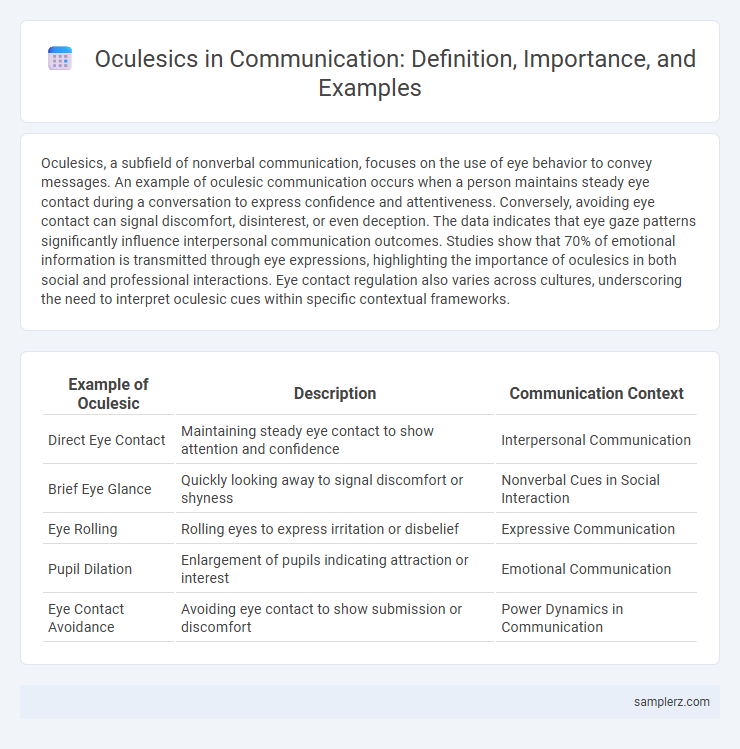Oculesics, a subfield of nonverbal communication, focuses on the use of eye behavior to convey messages. An example of oculesic communication occurs when a person maintains steady eye contact during a conversation to express confidence and attentiveness. Conversely, avoiding eye contact can signal discomfort, disinterest, or even deception. The data indicates that eye gaze patterns significantly influence interpersonal communication outcomes. Studies show that 70% of emotional information is transmitted through eye expressions, highlighting the importance of oculesics in both social and professional interactions. Eye contact regulation also varies across cultures, underscoring the need to interpret oculesic cues within specific contextual frameworks.
Table of Comparison
| Example of Oculesic | Description | Communication Context |
|---|---|---|
| Direct Eye Contact | Maintaining steady eye contact to show attention and confidence | Interpersonal Communication |
| Brief Eye Glance | Quickly looking away to signal discomfort or shyness | Nonverbal Cues in Social Interaction |
| Eye Rolling | Rolling eyes to express irritation or disbelief | Expressive Communication |
| Pupil Dilation | Enlargement of pupils indicating attraction or interest | Emotional Communication |
| Eye Contact Avoidance | Avoiding eye contact to show submission or discomfort | Power Dynamics in Communication |
Understanding Oculesics: The Role of Eye Behavior in Communication
Oculesics, a crucial aspect of nonverbal communication, involves the study of eye behavior such as gaze, eye contact, and blinking patterns to convey emotions and intentions. For example, sustained eye contact can indicate confidence and interest, while averted gaze may signal discomfort or distraction. Understanding these subtle eye movements enhances interpersonal communication by providing deeper insight into unspoken feelings and attitudes.
Types of Oculesic Cues in Everyday Interactions
Oculesic cues in communication include eye contact, gaze direction, and pupil dilation, which convey attention, interest, and emotional states. Prolonged eye contact can indicate confidence or confrontation, while brief glances often signal discomfort or avoidance. Subtle changes in pupil size reveal arousal or attraction, making these cues essential for interpreting nonverbal messages in social and professional interactions.
Eye Contact: Building Trust and Connection
Eye contact plays a crucial role in oculesic communication by fostering trust and establishing a strong emotional connection between individuals. Maintaining steady, natural eye contact conveys confidence, sincerity, and attentiveness, which enhances interpersonal understanding and rapport. Disruptions or avoidance of eye contact can signal discomfort or dishonesty, underscoring its importance in effective communication.
Avoiding Eye Contact: Signals of Discomfort or Deception
Avoiding eye contact during communication often signals discomfort, anxiety, or potential deception, as it can indicate an unwillingness to engage or reveal true feelings. This oculesic behavior disrupts rapport and may lead interlocutors to question the speaker's sincerity or confidence. Observing consistent avoidance of eye contact provides critical nonverbal cues that enhance understanding of underlying emotional states or intentions.
Blink Rate and Pupil Dilation: Hidden Emotional Indicators
Blink rate and pupil dilation serve as subtle oculesic cues in communication, revealing underlying emotions that words may not express. An increased blink rate often signals anxiety or stress, while pupil dilation can indicate heightened interest or arousal. These involuntary eye behaviors provide valuable nonverbal insights into a person's true feelings during interactions.
Cultural Differences in Oculesic Communication
Oculesic communication, the use of eye behavior in interaction, varies significantly across cultures, influencing interpretations and social dynamics. For instance, maintaining direct eye contact is often seen as a sign of confidence and honesty in Western cultures, while in many Asian cultures, prolonged eye contact can be perceived as disrespectful or confrontational. Understanding these cultural differences is crucial for effective intercultural communication and avoiding misunderstandings in global interactions.
Oculesics in Digital Communication: Video Calls and Beyond
Oculesics in digital communication, such as video calls, plays a crucial role in conveying attention, understanding, and emotional cues through eye contact and gaze direction. Effective eye engagement during virtual meetings enhances trust, reduces misunderstandings, and fosters stronger interpersonal connections despite physical distance. Advanced technologies in video conferencing platforms further optimize oculesic cues, integrating features like eye-tracking and adaptive framing to improve nonverbal communication.
Power Dynamics Expressed Through Eye Movements
Eye contact intensity and duration often reveal power dynamics in communication, with dominant individuals typically maintaining longer and more direct gazes to assert control. Subordinates or those with less power may avert their eyes or exhibit brief glances to signal submission or deference. The strategic use of eye movements, such as deliberate staring or controlled blinking, serves as nonverbal cues that reinforce hierarchical relationships and influence interpersonal interactions.
Oculesic Cues in Professional Settings
Oculesic cues in professional settings include maintaining appropriate eye contact during meetings to convey confidence and engagement, using controlled blinking to signal thoughtfulness, and employing intentional gaze shifts to manage turn-taking in conversations. These nonverbal signals enhance clarity, build trust, and facilitate smoother interactions among colleagues and clients. Mastery of oculesic communication supports effective leadership, negotiation, and collaborative teamwork in business environments.
Enhancing Communication Effectiveness with Oculesic Awareness
Maintaining appropriate eye contact during conversations significantly increases trust and engagement, making messages more persuasive and memorable. Recognizing cultural variations in oculesic behavior prevents misunderstandings and fosters smoother interpersonal interactions. Training in oculesic awareness enhances nonverbal communication skills, leading to clearer and more effective exchanges.

example of oculesic in communication Infographic
 samplerz.com
samplerz.com